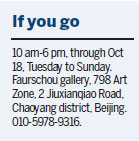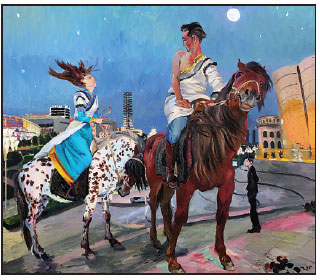Nomads get wider canvas
Updated: 2015-09-18 07:42
By Deng Zhangyu(China Daily)
|
|||||||||||
Oil painter Liu Xiaodong's latest works focus on people migrating to Ordos. Deng Zhangyu reports.
He is regarded as one of the most important oil painters in China.
But Liu Xiaodong has long focused on depicting people at the very bottom of societymigrant workers in cities, migrants from the Three Gorges Dam area and sex workers in Thailand among others.
These constant protagonists on Liu's canvases win him fame and help him set bidding records in auction houses.
Liu's latest works concentrate on nomadic people migrating to Ordos in the Inner Mongolia autonomous region - a fancy city labeled a ghost town by the media for its small population.
His show called Diary of An Empty City presented by the Faurschou Foundation in Beijing comprises 36 paintings, which Liu produced during his two-month stay in Ordos this summer.
Three large oil paintings show urban Mongolians sitting on horseback with the the city's landmarks like the stadium, the museum and the opera house in the background.
"I want to show the conflict between an agricultural society and industrial cities, as well as the contrast between urbanization and the lost nomadic culture.
"In fact, horses are not allowed into the city. I made a lot of effort to enable these people to ride horses in Ordos," says Liu, 52.
Known as a city of coal, Ordos has been transformed from a poor city located near a vast grassland into one of the richest ones in the region. Many of the locals used to earlier live on the prairies.
Liu says the models in his paintings are people making a living offering horse rides to visitors at a tourist spot near the city.
The painter drew horses on photos he took of the city. He even drew a black frame on a photo of a horse head.
"Horses are a symbol of nomadic culture. But the city has no horses now. The black framed horse looks like it's dead, just like the disappearance of nomadic culture in the wave of urbanization," says Liu.
Liu likens his painting to "doing a project". He first finds the place and the people he wants to depict. Then he lives in a camp temporarily built to paint on the spot. A large picture often takes him half a month. Besides painting pictures, he also keeps a diary after a whole day's painting outside.
He also takes photos of the place he chooses to paint and hires a documentary team to record all the activities related to his painting.
The paintings, the diaries, the photos and the documentaries are shown together as a whole to the public.
The documentary Still Life, which Liu invited well-knowan director Jia Zhangke to make in 2005 during Liu's stay in the Three Gorges Dam area - depicting migrants from there - won the Golden Lion Award at the Venice International Film Festival a year later.
Dong, another documentary Jia produced recording Liu's creation process, was also nominated for the Golden Lion Award.
"Liu is a very unique artist. He is a conceptual artist rather than a painter. The issues he talks about are not only the ones China faces. The problems of migration, minorities, women and urbanization, they are issues facing the world," says Jerome Sans, the show curator.
He met Liu in 2008 and that started their cooperation.
Sans says each of Liu's projects takes two to three months, so the number of works he produces every year is small compared to other artists.
"Two projects a year. That's the best working pace for me. After months of painting, I have to return to my life and think for months, and then start again," says Liu.
Usually, he paints three to four large pictures in one project.

Liu's work Disobeying the Rules, depicting a group of naked workers on a truck, was sold for $8.5 million at Sotheby's auction in Hong Kong last October.
Before that, some of his works had already fetched millions of dollars at auction houses in China.
Liu has visited most cities in China and many abroad. But every time he goes to a city, he is there to find ordinary people to paint. Jade diggers in Hotan in the Xinjiang Uygur autonomous region, soldiers in Taiwan, Chinese-Indonesians and even his friends in his hometown. They all go on his canvas.
"I like them. They are very real and don't hide their emotions. They're much easier to deal with.
"Sometimes their lives are bad, and unfair things happen to them, but they face them positively," says Liu of his models. He started portraying the underclass in the 1990s.
Sans says that like his models, the artist is very real. He does things by himself, from replacing broken bulbs to fixing leaking sewage.
After completing a project, Liu says he stays in his studio, drinking tea and meeting friends. Then, when all his thoughts come together, he sets out for another project.
So where will he go next?
Liu says he chooses the place on a whim.
Contact the writer at dengzhangyu@chinadaily.com.cn
|
Painter Liu Xiaodong stands in front of one of his latest works about Ordos, Inner Mongolia autonomous region, showing nomads riding on horseback with the vast city stadium in the background. Another painting from the series (below). Photos By Zhang Wei / China Daily |

(China Daily 09/18/2015 page22)
Today's Top News
EU's Tusk calls EU summit on migration
At least three killed as powerful quake hits off coast of Chile
Australian father takes on Chinese drug dealers after son's death
Senior securities watchdog official under investigation
Transactions on overseas real estate projected to hit $220b
Migrants in Serbia reroute to Croatia
UK Labour leader Corbyn takes on ritual at first Cameron duel
Britain marks 75th anniversary of victory in Battle of Britain
Hot Topics
Lunar probe , China growth forecasts, Emission rules get tougher, China seen through 'colored lens', International board,
Editor's Picks

|

|

|

|

|

|







